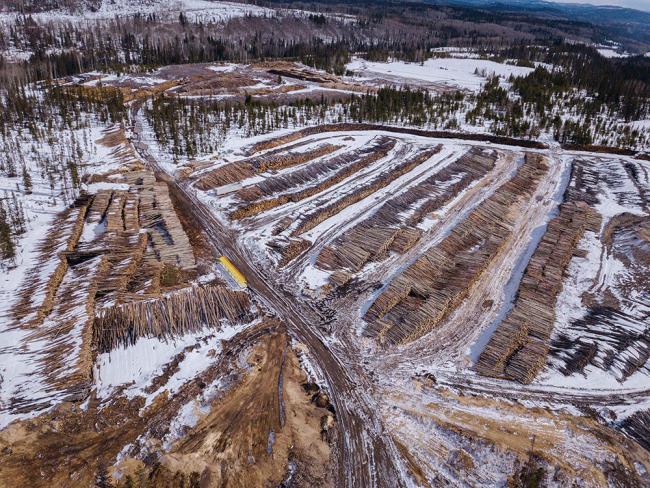Articles Menu

Mar. 7, 2022
At mid-afternoon on Monday, senior staff at B.C.’s Forests Ministry were told that one of their highest-ranking members — the province’s chief forester, Diane Nicholls — was entering a revolving door that would sweep her seamlessly out of government and into the industry her ministry regulates.
“Diane is leaving us to further her work in sustainable forestry in the private sector in the role of VP [vice-president] sustainability for North America with Drax,” Rick Manwaring, forests deputy minister, said in an email to 30 of his colleagues. Drax, Manwaring added, “is a United Kingdom-based energy, carbon capture and pellet company and is establishing its presence in both the U.S. and Canada.”
Whether Manwaring himself chose those words or was assisted in drafting them by government communications staff is unknown.
But what can be said is that his email downplayed what Drax is or what its “presence” means for B.C.’s forests.
And here’s something Manwaring didn’t say about Nicholls. Two years ago she chose to be in an industry-funded video extolling the virtues of wood pellets.
The video was produced by the Wood Pellet Association of Canada. In it, Nicholls makes the same claims promoted by her future employer. She says that wood pellets are part of the “circular” forest industry where wood waste from one operation becomes the critical feedstock for another.
“When you look at pellet production in British Columbia, it’s part of building that circular economy in the forest sector. It uses residuals from sawmill production that may not be used otherwise and it also is starting to use harvest residuals that we know is not being used currently. And that is a win, because it’s something that is an added value for the benefits of British Columbians,” she says.
“What I see the pellet producers doing is opening our minds in B.C. by utilizing parts of the tree that currently aren’t necessarily used always,” she continues.
“And being able to find a manufacturing potential for that fibre and find a market for that manufactured product as in pellets and be able to add value to the economy of British Columbia, without impacting how much we harvest in any way, shape or form.”
Unfortunately, the assertion that wood pellet production does not impact harvesting is just not true.
Video footage and photographs from three pellet mills show huge numbers of whole logs piled up at facilities in Burns Lake, Smithers and Houston — facilities all once owned by Pinnacle and now owned by Drax.
Moreover, as chief forester, in 2017 Nicholls noted that in the Prince George area of B.C. alone logging companies had delivered an estimated 2.4 million cubic metres of logs to wood pellet mills and pulp and paper mills over the preceding five years.
Many of those logs were then turned directly into wood pellets. This directly contradicts the pellet industry’s claim that it mostly utilizes “waste” or “residual” wood from the sawmill industry.
Len Vanderstar, a retired professional forester and professional biologist who has worked in various positions with the provincial government, said he and other former government employees were uncomfortable when they saw Nicholls appear in the Wood Pellet Association of Canada video.
“Myself and some others questioned the perception of a conflict of interest,” Vanderstar said when contacted by phone following Manwaring’s announcement.
The chief forester, the government said when Nicholls got the job in 2016, “is responsible for determining timber harvest levels for each timber supply area and tree farm licence in the province” and called on her to “provide key strategic guidance and direction on forest stewardship.”
Michelle Connolly, director of Conservation North, a Prince George-based group that seeks to protect the Interior region’s remaining primary forests — those forests not yet subject to industrial logging — said she is concerned by Nicholls’ pending move from government to one of the world’s top wood pellet users. Her concern comes in part because of the evidence that tracts of primary forest in the region have been purpose-logged to make pellets.
“Do movements like this facilitate the regulatory capture we see in B.C., where policies and programs made by government are ultimately authored by the industry?” she asks.
Regulatory capture refers to situations where a government regulator tasked with promoting the public interest instead promotes the interests of the industry it is meant to oversee. A common feature of captured regulators is the “revolving door” Nicholls entered when she chose to leave government for an industry job. It’s a portal that many of her predecessors in other provincial entities such as the Oil and Gas Commission have already passed through.
And it raises questions about whose interests are really being served as publicly owned resources are effectively managed out of existence.
Nicholls’ pending move from government to industry comes at a pivotal moment. A fight over the last of what remains of the province’s old-growth forests is underway, following a government announcement last year to defer logging in a portion of those old-growth or primary forests that remain.
At the same time, the pellet industry needs access to a whole lot more such forests.
In letting his colleagues know about Nicholls’ pending departure, Manwaring said that the soon-to-be-former chief forester was leaving the ministry in good shape to continue its work of “caring” for B.C.’s forests.
Based on recent experience, it looks like “care” could equate to a whole lot more trees becoming pellets to be burned.
[Top photo: Logs piled up awaiting conversion to wood pellets at a factory now owned by multinational Drax Group. Photo from Stand.earth.]